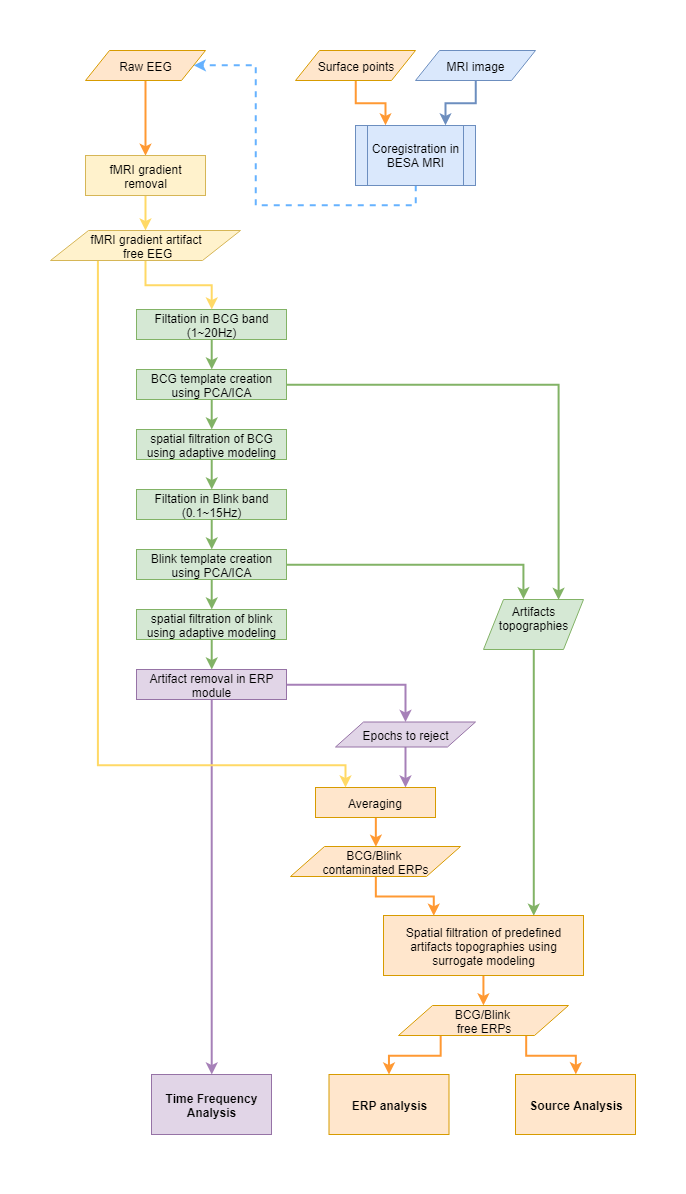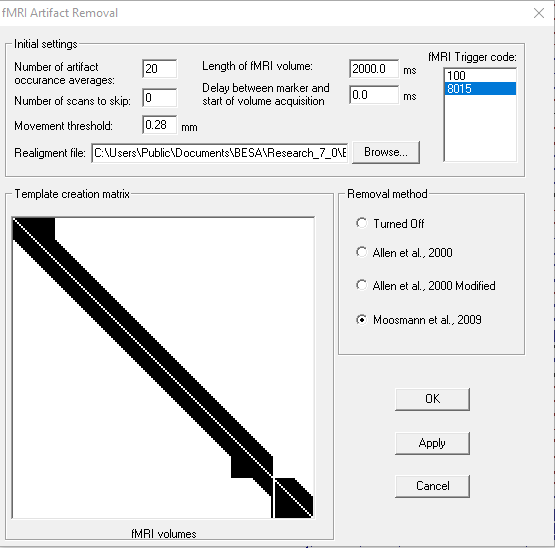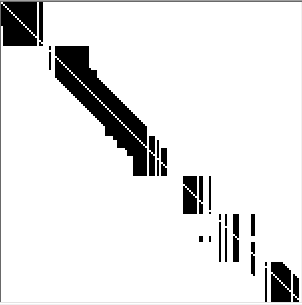Difference between revisions of "Pipeline for simultaneous EEG-fMRI recording"
| Line 28: | Line 28: | ||
==fMRI gradient removal== | ==fMRI gradient removal== | ||
| + | Please note that you need hardware clock synchronization before removing fMRI gradient artifact. Do not perform any sampling rate change (especially do not downsample!) before performing this preprocessing step. Clock synchronization assures alignment between triggers present in EEG data in realtion to start of fMRI volume acquistion as well as constistent span between samples containing artifact. That mean that every epoch containing fMRI induced artifact is identical. | ||
To remove fMRI gradient go to menu ''Artifact\fMRI artifact...'' Following dialog box will appear: | To remove fMRI gradient go to menu ''Artifact\fMRI artifact...'' Following dialog box will appear: | ||
| + | |||
[[File:FMRI_dialogbox.PNG]] | [[File:FMRI_dialogbox.PNG]] | ||
| Line 45: | Line 47: | ||
==BCG artifact correction== | ==BCG artifact correction== | ||
| + | ===How to create proper artifact template?=== | ||
| + | For BCG artifact removal we recommend using PCA based template creation. ICA approach is a bit difficult since BCG artifac is a complex artifact (constituted usually from more than 3 components). Also the main assumption of ICA is violated - components are dependent - please keep in mind that BCG artifact is induced by, Hall effect, pulsating skin and head movement all related to the heart beat. Most importantly the BCG part related to the movement can consist of six components in worst scenario - movement in X, Y and Z direction and rotation in yaw | ||
| + | |||
| + | |||
==Good practice== | ==Good practice== | ||
| + | Please keep in mind that simultaneous EEG-fMRI recording is a difficult yet powerful technique. The following rules could help one to perform a successful experiment: | ||
| + | * Remember that proper '''EEG and MRI hardware clock syncrhonization''' is esential for fMRI gradient artifact removal. BESA Research internaly perform checks if the synchronizaiton is sufficient however it is user responsibility to maintain hardware configuraiton. Under any circumstances '''do not change EEG data sampling rate''' prior fMRI gradient removal procedure. | ||
| + | * For an ERP experiment remember to introduce temporal '''jitter between trials''' (e.g. a random value in the range of ±200 ms). Also, applying a pure EEG or a pure fMRI paradigm will probably have the effect that one of the modalities will not show satisfying results. Proper paradigm preparation is essential for success. Some further guidelines can be found here: (Rusiniak et al., 2013a). | ||
| + | * Inform your subject how important it is '''not to move'''. | ||
| + | * Keep electrode to skin '''impedance as low as possible'''. | ||
| + | * The EEG-fMRI recording session should be long enough to allow for proper artifact creation. Usually the experiment should '''last at least 6 minutes'''. | ||
| + | * At the same time try to '''limit the time of experiment to a minimum''' and preferably perform EEG-fMRI registration before other sequences to limit movement due to an inconvenient supine position. | ||
| + | * From the standard position, move the '''subject about 4 cm towards caudal direction''' to reduce artifacts: The MRI laser crosshair should be not in the Nasion position but in the middle of forehead (Mullinger et al., 2011). | ||
| + | * Especially for the first few registrations '''repeat the experiment outside of the MR bore''' to compare results. | ||
==References== | ==References== | ||
| + | * Abreu, R., Leal, A., Figueiredo, P., 2018. EEG-Informed fMRI: A Review of Data Analysis Methods. Front. Hum. Neurosci. 12, 29. https://doi.org/10.3389/fnhum.2018.00029 | ||
| + | * Allen, P.J., Josephs, O., Turner, R., 2000. A Method for Removing Imaging Artifact from Continuous EEG Recorded during Functional MRI. NeuroImage 12, 230–239. https://doi.org/10.1006/nimg.2000.0599 | ||
| + | * Moosmann, M., Schönfelder, V.H., Specht, K., Scheeringa, R., Nordby, H., Hugdahl, K., 2009. Realignment parameter-informed artefact correction for simultaneous EEG–fMRI recordings. NeuroImage 45, 1144–1150. https://doi.org/10.1016/j.neuroimage.2009.01.024BESA® Research 7.0 | ||
| + | * Mullinger, K.J., Yan, W.X., Bowtell, R., 2011. Reducing the gradient artefact in simultaneous EEG-fMRI by adjusting the subject’s axial position. NeuroImage 54, 1942–1950. | ||
| + | * Rusiniak, M., Lewandowska, M., Wolak, T., Pluta, A., Milner, R., Ganc, M., Włodarczyk, A., Senderski, A., Śliwa, L., Skarżyński, H., 2013a. A modified oddball paradigm for investigation of neural correlates of attention: a simultaneous ERP–fMRI study. Magn. Reson. Mater. Phys. Biol. Med. 26, 511–526. https://doi.org/10.1007/s10334-013-0374-7 | ||
| + | * Rusiniak, M., Wolak, T., Lewandowska, M., Cieśla, K., Skarzynski, H., 2013b. The relation between EPI sequence parameters and electroencephalographic data during simultaneus EEG-fMRI registration: an initial report., in: ESMRMB 2013 Congress, Book of Abstracts, Saturday. Presented at the ESMRMB, Springer, Toulouse, p. 661. https://doi.org/10.1007/s10334-013-0384-5 | ||
Revision as of 15:08, 24 May 2018
| Module information | |
| Modules | BESA Research Basic or higher |
| Version | 7.0 or higher |
Contents
Pipeline for simultaneous EEG-fMRI recording
Before you start
- You have a clock synchronization between EEG and MRI systems
- You have jitter between trials in ERP experiment (i.e. random value of ±200ms). Some further guidelines about paradigm creation can be found here: (Rusiniak et al., 2013a).
- The subject movement is limited to minimum.
- Electrode to skin impedance is as low as possible.
- EEG-fMRI recording session was long enough to allow for proper artifact creation. Usually experiment should last at least 6 minutes.
- Especially for first few registrations repeat the experiment outside of the bore to compare results.
Pipeline overview
The recommended pipeline of processing EEG data registered during fMRI session looks as follows:
Please note that some steps are grouped with colors:
- orange color indicate steps that are part of typical processing of ERP data.
- blue color indicate optional, yet strongly recommended EEG-MRI data co-registration.
- yellow color marks the steps related to fMRI gradient artifact removal
- green steps are reserved for BCG/blink artifact correction
- violet color indicate steps for time frequency analysis. Here also information about rejected epochs is provided for averaging.
fMRI gradient removal
Please note that you need hardware clock synchronization before removing fMRI gradient artifact. Do not perform any sampling rate change (especially do not downsample!) before performing this preprocessing step. Clock synchronization assures alignment between triggers present in EEG data in realtion to start of fMRI volume acquistion as well as constistent span between samples containing artifact. That mean that every epoch containing fMRI induced artifact is identical. To remove fMRI gradient go to menu Artifact\fMRI artifact... Following dialog box will appear:
Some of the parameters are strongly dependent on fMRI acquisition:
- Length of fMRI volume - it should be exactly the time of volume acquisition (time when MR gradients are ON).
- fMRI trigger code - code in the EEG recording provided by MR scanner.
- Delay between marker and start of volume acquisition - a delay between marker in EEG provided by MR scanner and real start of fMRI volume acquisition.
- Number of scans to skip - if MR volumes acquired to stabilize magnetization has a corresponding marker in EEG data adjust this value to match number of volumes used for fMRI analysis.
- Realignment file - direct output file from first step of fMRI analysis (realignment). We support SPM, FSL, AFNI, Brainvoyager
Other should be carefully selected depending on the data:
- Number of artifact occurrence averages - The default value is 16. That means that 8 preceding and 8 proceeding artifact occurrences are used to create averaged template. Note that if odd number is used (ie. 17) the signal from volume currently correcting is used for averaging as well. If a larger number is selected then the artifact is more stable and differentiated from EEG data. However if there is a lot of movement during the recording session the artifact template will be incorrect. A smaller number of artifact occurrences for averaging or more advanced methods of artifact removal should be selected.
- Movement threshold - this parameter is only used for two advanced methods: Allen et al. 2000 Modified and Mossmann et al. 2009. When changing this value check how the template creation matrix changes. if you note that matrix is very segmented (check below) you might consider increasing the threshold value
BCG artifact correction
How to create proper artifact template?
For BCG artifact removal we recommend using PCA based template creation. ICA approach is a bit difficult since BCG artifac is a complex artifact (constituted usually from more than 3 components). Also the main assumption of ICA is violated - components are dependent - please keep in mind that BCG artifact is induced by, Hall effect, pulsating skin and head movement all related to the heart beat. Most importantly the BCG part related to the movement can consist of six components in worst scenario - movement in X, Y and Z direction and rotation in yaw
Good practice
Please keep in mind that simultaneous EEG-fMRI recording is a difficult yet powerful technique. The following rules could help one to perform a successful experiment:
- Remember that proper EEG and MRI hardware clock syncrhonization is esential for fMRI gradient artifact removal. BESA Research internaly perform checks if the synchronizaiton is sufficient however it is user responsibility to maintain hardware configuraiton. Under any circumstances do not change EEG data sampling rate prior fMRI gradient removal procedure.
- For an ERP experiment remember to introduce temporal jitter between trials (e.g. a random value in the range of ±200 ms). Also, applying a pure EEG or a pure fMRI paradigm will probably have the effect that one of the modalities will not show satisfying results. Proper paradigm preparation is essential for success. Some further guidelines can be found here: (Rusiniak et al., 2013a).
- Inform your subject how important it is not to move.
- Keep electrode to skin impedance as low as possible.
- The EEG-fMRI recording session should be long enough to allow for proper artifact creation. Usually the experiment should last at least 6 minutes.
- At the same time try to limit the time of experiment to a minimum and preferably perform EEG-fMRI registration before other sequences to limit movement due to an inconvenient supine position.
- From the standard position, move the subject about 4 cm towards caudal direction to reduce artifacts: The MRI laser crosshair should be not in the Nasion position but in the middle of forehead (Mullinger et al., 2011).
- Especially for the first few registrations repeat the experiment outside of the MR bore to compare results.
References
- Abreu, R., Leal, A., Figueiredo, P., 2018. EEG-Informed fMRI: A Review of Data Analysis Methods. Front. Hum. Neurosci. 12, 29. https://doi.org/10.3389/fnhum.2018.00029
- Allen, P.J., Josephs, O., Turner, R., 2000. A Method for Removing Imaging Artifact from Continuous EEG Recorded during Functional MRI. NeuroImage 12, 230–239. https://doi.org/10.1006/nimg.2000.0599
- Moosmann, M., Schönfelder, V.H., Specht, K., Scheeringa, R., Nordby, H., Hugdahl, K., 2009. Realignment parameter-informed artefact correction for simultaneous EEG–fMRI recordings. NeuroImage 45, 1144–1150. https://doi.org/10.1016/j.neuroimage.2009.01.024BESA® Research 7.0
- Mullinger, K.J., Yan, W.X., Bowtell, R., 2011. Reducing the gradient artefact in simultaneous EEG-fMRI by adjusting the subject’s axial position. NeuroImage 54, 1942–1950.
- Rusiniak, M., Lewandowska, M., Wolak, T., Pluta, A., Milner, R., Ganc, M., Włodarczyk, A., Senderski, A., Śliwa, L., Skarżyński, H., 2013a. A modified oddball paradigm for investigation of neural correlates of attention: a simultaneous ERP–fMRI study. Magn. Reson. Mater. Phys. Biol. Med. 26, 511–526. https://doi.org/10.1007/s10334-013-0374-7
- Rusiniak, M., Wolak, T., Lewandowska, M., Cieśla, K., Skarzynski, H., 2013b. The relation between EPI sequence parameters and electroencephalographic data during simultaneus EEG-fMRI registration: an initial report., in: ESMRMB 2013 Congress, Book of Abstracts, Saturday. Presented at the ESMRMB, Springer, Toulouse, p. 661. https://doi.org/10.1007/s10334-013-0384-5


